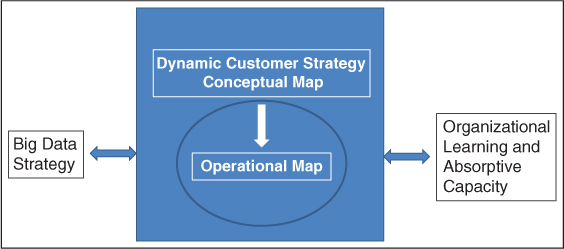Chapter 3Operationalizing Strategy
Models, whether conceptual or statistical, are a big part of Dynamic Customer Strategy. To accelerate organizational learning, we use conceptual models to make our view of how the market operates explicit so that everyone can understand not just the what of strategy but also the why.
But conceptual models don't feed our families—we have to take our conceptual models and put them into operation. That's the subject of this chapter—taking the conceptual and making it operational. Using our DCS and Big Data Framework in Figure 3.1, you can see we focus on that relationship between the conceptual and what we actually do, the operational.

Figure 3.1 The Big Data and Dynamic Customer Strategy Framework
In this chapter, we focus on making the conceptual real, or operation, as highlighted with the oval in the framework.
Conceptual to Operational
If you recall in Chapter 2, we discussed models of loyalty to understand how you build your concept map. In that chapter, we emphasized the concept map, but here in Figure 3.2, I've condensed the model to focus on performance in order to simplify our discussion. Recall, too, that there are two types of loyalty: behavioral and attitudinal. Which one is meant by our model? Which form of loyalty is more important?
Figure 3.2 A Simple Model of Loyalty
For nearly two decades, the promises of increased customer ...
Get Analytics and Dynamic Customer Strategy: Big Profits from Big Data now with the O’Reilly learning platform.
O’Reilly members experience books, live events, courses curated by job role, and more from O’Reilly and nearly 200 top publishers.

